California's Gavin Newsom wants to lead the way to a post-Bernie, post-Hillary party
LOS ANGELES — On a recent Thursday afternoon, a long blue-and-white bus cut through L.A.’s glacial traffic, pivoted slowly into the Ladera Center strip mall and stopped in front of Stakely’s Barber Salon. “Gavin for Governor,” it said on the side. Moments later, Gavin Newsom, the former mayor of San Francisco, two-term lieutenant governor of California and current Democratic candidate for the state’s top job, descended the stairs in white shirtsleeves and a loosened navy tie and, though his cheeks seemed as smooth as the rest of him, sauntered inside for a shave.
In a few days, Newsom would learn that he had won the Golden State’s nonpartisan, top-two primary with 33 percent of the vote — no surprise, given that he’d led the crowded field in every poll taken since campaigning began. More consequential was the news that the other Democratic frontrunner, former L.A. Mayor Antonio Villaraigosa, had failed to secure the second spot in the general election, and that a little-known Republican venture capitalist from Illinois named John Cox had advanced instead.
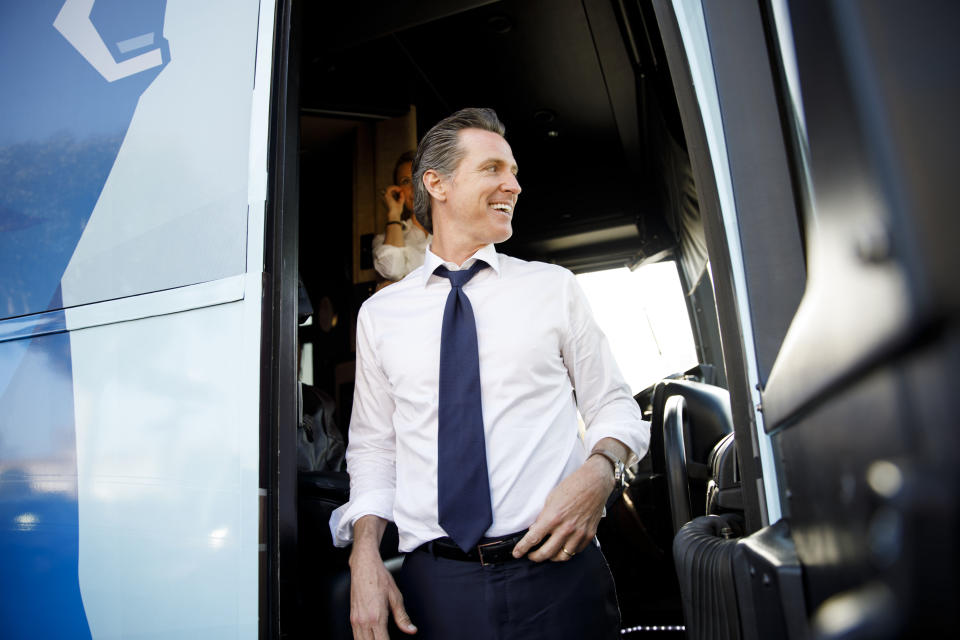
In a state where Democrats dominate every major office, where Hillary Clinton defeated Donald Trump by 3 million votes and where registered independents now outnumber Republicans, observers had always given Cox a much slimmer chance than Villaraigosa of besting Newsom in a head-to-head contest. Having Cox as his opponent wouldn’t quite guarantee victory to Newsom, but it would suddenly become very hard to see how he could lose.
For the moment, however, Newsom wasn’t taking anything for granted. Hence the trip to Stakely’s, one of the final stops on a carefully choreographed bus tour that carried him from San Francisco to San Diego in the week before the primary. The point, as is often the case in California, which is a vast and very expensive place to run for office, wasn’t to play to the crowd. Other than a few barbers, there was no crowd. The point was to play to the cameras; to get in, get out and get on the evening news, where a not-insignificant number of L.A.’s millions of voters could see the candidate hanging out at a black barbershop in black South Los Angeles with one of the city’s most prominent black politicians, County Supervisor Mark Ridley Thomas, who met Newsom at the door.
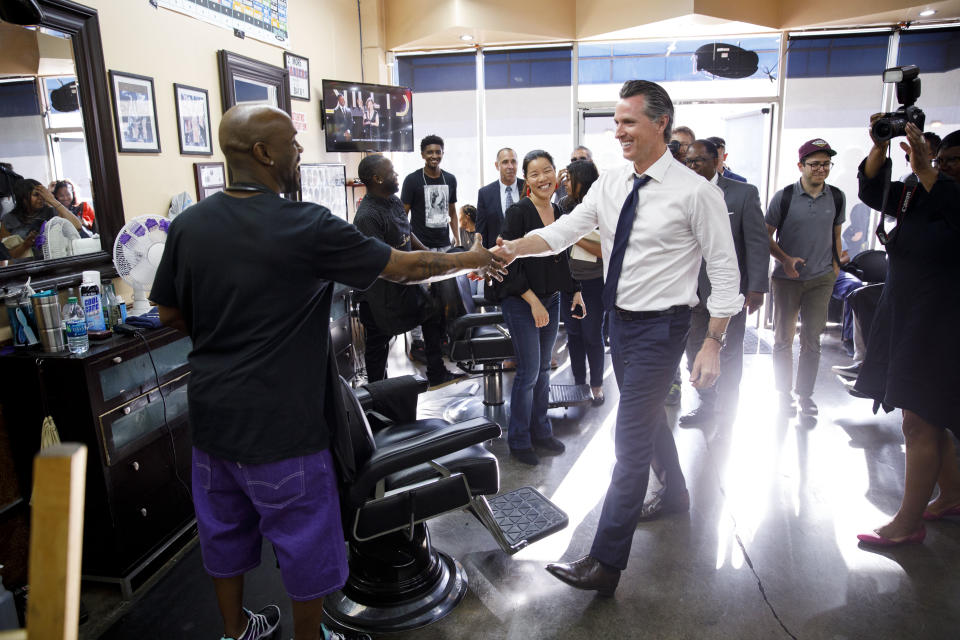
Newsom — who is 6’3″, with immaculate teeth, a jock’s swagger and more than a passing resemblance to Patrick Bateman, the Christian Bale character from American Psycho — didn’t miss a beat. He laughed loudly, gave dap and posed for selfies. Eyeing the old-school basketball photos on Stakely’s yellow walls and the NBA finals on its two TVs, he name-dropped the Lakers and the Celtics and LeBron. He acted surprised when Thomas “convinced” him to get a shave. He joked that he’d like his barber, a man named Brando, to buzz a few of “those zigzag lines” into the side of his head, then recoiled the instant Brando touched his gel-slicked hair with a comb. “Just a shave,” Newsom clarified. “There goes my closing television ad.” Fully reclined, his face slathered with shaving cream, Newsom mocked his own photo op. “Anybody got a baby?” he shouted. “I should be cuddling a baby right now.”
As the shave wound down, Brando handed Newsom a mirror. For a split second, Newsom held it. Then he did something revealing. Realizing that the entire pool of photographers was now scrambling to get a shot of him gazing at his own visage, which the New Yorker magazine once described as “provokingly handsome,” Newsom laughed, shook his head and thrust the mirror back at Brando.
“As a politician and former mayor, I know better than that,” he said. He laughed again. “You guys almost got me.”
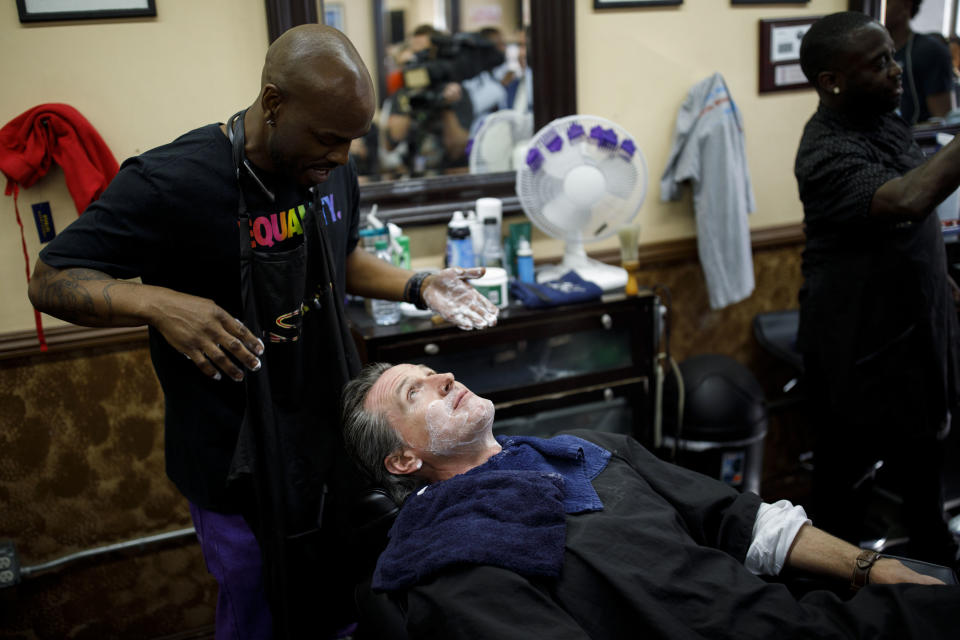
*****
Newsom, 50, has been a politician nearly half his life. In public, at least, he’s always seemed like a man with one eye on the mirror — hyperconscious of himself and his surroundings, and skillfully, seamlessly adjusting the former to more favorably reflect the latter.
So far, his silken self-awareness — his ability to sense what you want from him and adapt accordingly — has proved to be an asset. In fact, he’s never lost an election. But if he wins this one, actually governing California — and trying, at the same time, to lead his party by example — will test the limits of his suppleness.
When Newsom first surfaced in 1997 as a 29-year-old wine-and-hospitality entrepreneur who had been appointed to a vacant seat as a San Francisco supervisor, he touted himself, in the fashion of the time, as a “dogmatic fiscal conservative.” Running for reelection, Newsom paid to appear on a GOP mailer and accepted the endorsement of the city’s Republican Party. After election as mayor in 2003, he shifted leftward, making headlines the following year by becoming the first public official in America to issue same-sex marriage licenses. Then, at the height of Web 2.0 mania, he wrote a book called “Citizenville: How to Take the Town Square Digital and Reinvent Government,” which was so optimistic about outsourcing state services to individuals, via apps, that Newt Gingrich called it “a blueprint for the Republican Party.”
Now, as a candidate for governor at a time of fake news, rising populism and a progressive base that has responded by turning against both Davos Democrats and Silicon Valley, Newsom no longer stumps about “Citizenville.” (“Every time I talk about participatory platforms,” he tells Yahoo News, “my campaign team literally tries to choke me.”) Instead, he is promoting a liberal wish list that would, if enacted, represent one of the largest government expansions California has ever seen: a statewide single-payer health care system; universal preschool; full-service community schools, open every day; hundreds of thousands of new affordable housing units per year; a state energy grid run solely on renewable energy; and a state bank dedicated to financing infrastructure projects, small businesses and the burgeoning marijuana industry.

Newsom insists that his core values have never changed. “I take a back seat to few in terms of my progressive policy positions on social issues,” he says. “I’ve always had those. And I haven’t budged in terms of being someone who believes in fiscal discipline.”
“But it’s always about what we emphasize,” he explains. “And it’s about what we’re allowed to emphasize as well.”
What Newsom has decided to emphasize — along with when and where he’s emphasizing it — could shape the future of the Democratic Party. The next presidential contest is more than two years away; the next generation of party leaders is stuck in the Senate, where Republicans will prevent them from accomplishing much of anything. Meanwhile, rank-and-file Democrats are searching for a model of post-Obama progressivism that can transcend the tired debates between Bernie Bros and Hillarybots, populism and identity politics. Resistance to President Trump shows no signs of subsiding. And California, home to the world’s fifth-largest economy, more people than any other state in America, and a totally powerless GOP, is emerging as a kind of alternate reality to Trump’s Washington: a place, that is, where progressive solutions to America’s most pressing problems, from income inequality to education to health care, could actually be implemented, on an unmatched scale.
In other words, the state’s next leader has the potential to be a lot of things to a lot of people. A pacesetter for progressive policy. A template for Democratic unity. Trump’s Twitter nemesis.
“As a gubernatorial candidate in the largest state in the country, and as a Democrat, I would be hard pressed to tell you what the Democratic Party’s message is, outside of our opposition to Donald Trump,” Newsom says. “That’s a pretty damning statement, and I’m sorry I have to make it.”
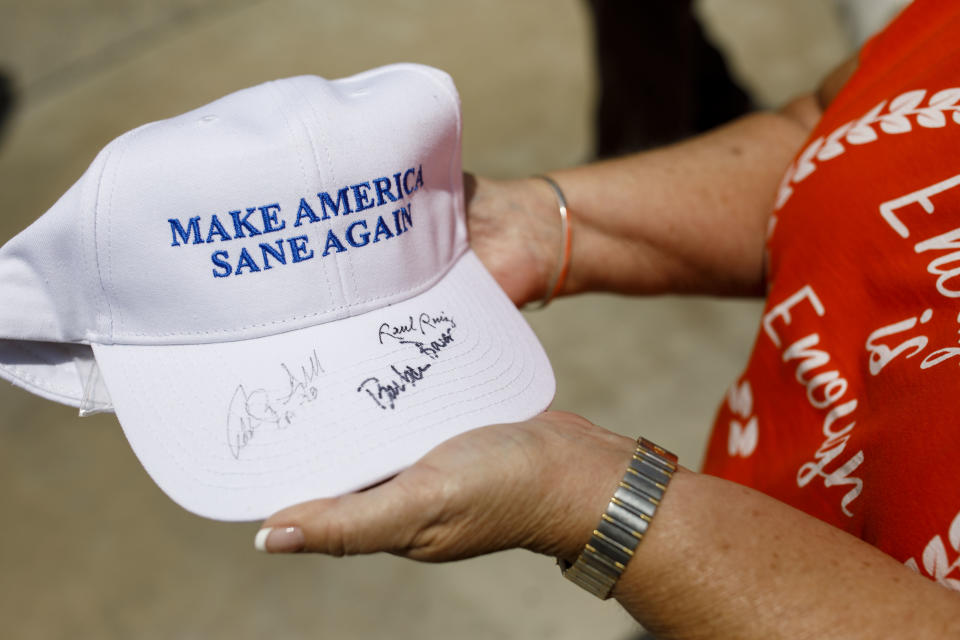
“If the Democratic Party writ large is not the opposition party, then California must be the opposition party,” he adds. “And we can’t, in that light, just be the resistance. The future happens here first. We have to be the positive alternative that is missing on a national level.”
Newsom, as usual, knows what the moment wants. And as usual, he’s promising that he can provide it — all of it. The question is whether he’s promising too much.
*****
Before Stakely’s, Newsom’s bus had stopped at the Mizell Senior Center in Palm Springs, the first and only municipality in America with an all-LGBTQ city council, for a town hall co-sponsored by Equality California, the nation’s largest statewide LGBTQ advocacy organization. It was a kind of homecoming.
“You know him for his courageous, principled stand on marriage equality, way back in 2004 — before it was popular, other than in the LGBT community, and when most folks in the Democratic Party thought it wasn’t time to support full marriage equality,” said Equality California executive director Rick Zbur in his introduction. “Gavin Newsom put his career on the line because he knew that when it comes to fighting for civil rights, for equality, we can’t let politics get in the way of doing what’s right.”
The crowd went wild. Everything Zbur said was conveniently on message; Newsom’s slogan is “Courage for a Change,” and exhibit A is always his decision, as mayor, to defy state law and open city hall to thousands of same-sex weddings. “Today we can confidently say is the first day in the state of California that we are providing marriage equally and fairly to everyone, and denying no one their right and their opportunity to live their lives out loud,” Newsom announced in his campaign’s debut digital ad, which begins with 14-year-old footage of gay couples exchanging vows. “It takes courage to make real change,” a voiceover adds. “That’s Gavin Newsom.”
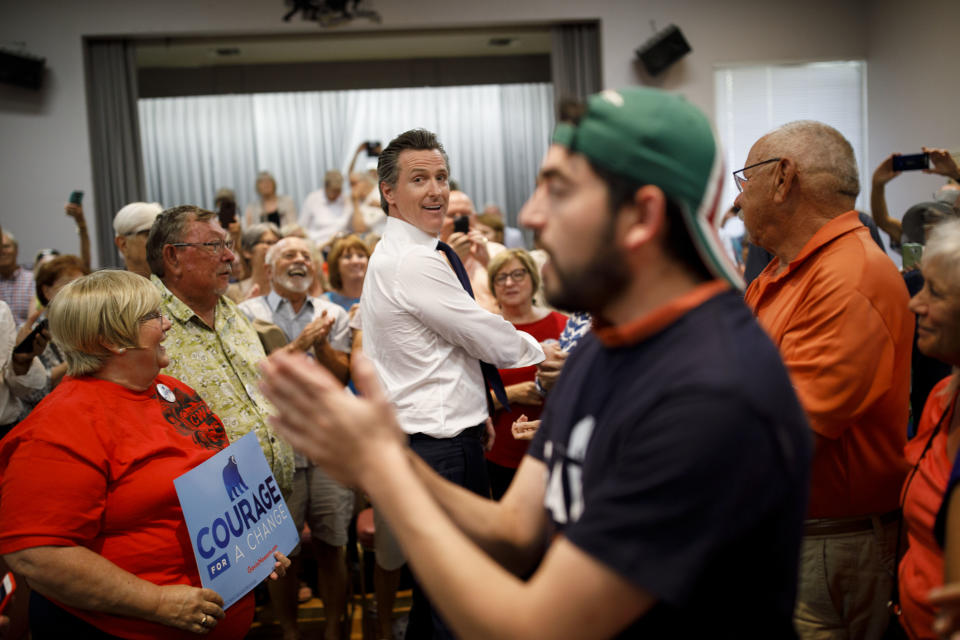
Politics aside, though, everything Zbur said also happens to be true. Newsom’s decision wasn’t popular at the time — not in California, and not in the Democratic Party. After George W. Bush won reelection and 11 states passed anti-gay-marriage amendments in 2004, Massachusetts Rep. Barney Frank, himself gay, accused Newsom of helping to “galvanize Mr. Bush’s conservative supporters … by playing into people’s fears of same-sex weddings,” as the New York Times put it. California Sen. Dianne Feinstein, one of Newsom’s early mentors, concurred, claiming that the “whole issue has been too much, too fast, too soon.” It would take another eight years for a Democratic president, Barack Obama, to finally come out in favor of full marriage equality.
By getting ahead of his party and his state, Newsom imperiled his political ambitions as well. Yes, the mayor’s approval ratings soared in San Francisco, perhaps the most socially liberal city in America. But the rest of California lagged behind. Just four years later, backers of Proposition 8, a measure to amend the state constitution to prohibit same-sex marriage, cut a campaign ad that began with a cocksure Newsom declaring victory. (“This door’s wide open now,” he says in the clip. “It’s gonna happen — whether you like it or not.”) A few months later, Prop 8 passed with 52 percent of the vote, and just like that, California outlawed same-sex marriage for the next five years. When Newsom tried to challenge Jerry Brown for governor in 2010, he flopped; polls routinely showed him trailing by 20 percentage points or more. He bowed out seven months before the primary.
Today, the rest of the Democratic Party, and much of the rest of the country, has caught up with Newsom. “History has proven that Gavin Newsom made the right decision, a very bold decision,” Feinstein recently told the Los Angeles Times. And that’s how the candidate, now vindicated by the march of progress, has been selling himself to the electorate: as a “bold” visionary with the “courage” to do “big” things.
But Newsom’s maneuvering on marriage wasn’t simply about boldness or courage. Neither were the other ahead-of-the-curve achievements he likes to tout, from the universal health care system he implemented in San Francisco to the ballot initiatives he championed to legalize recreational marijuana and require background checks for ammunition purchases. They were also examples of something more clear-eyed, and possibly consequential, than that: Newsom’s willingness to leverage his most powerful asset — his position of privilege — to promote cutting-edge progressive causes.

When Kate Kendell, executive director of the National Center for Lesbian Rights, first heard that Newsom was planning to unilaterally legalize same-sex marriage in San Francisco, she was afraid it might be premature. But she quickly came around. One of the reasons, she later told the Los Angeles Times, was that Newsom himself lent the issue a kind of crossover appeal. “This move by Newsom played against type,” she explained. “People did not expect this Irish Catholic, straight … middle-of-the-road moderate to do something so audacious.”
In effect, Newsom was operating from a position of both personal privilege (as a “mainstream” figure validating a “fringe” cause) and political privilege (as the mayor of one of America’s most gay-friendly cities), and he was using that privilege to push an envelope that other politicians felt they couldn’t afford to push. Similar, if less dramatic, moments followed: his decision to side with workers during a citywide 2004 hotel strike, even though hotel management had contributed generously to his campaign and the union had bitterly opposed him; his successful 2007 push for countywide universal health care access — the first system of its kind — despite his initial reluctance, as a businessman himself, to ask employers to pony up.
Newsom’s biography suggests that privilege has always been a double-edged thing for him — an advantage and a weapon. Perhaps that’s because his own privilege is shallower than it seems.
A recent New Yorker article described Newsom as “the scion of a wealthy San Francisco family.” That’s not quite true. Newsom’s father, retired state appellate Judge William A. Newsom III, is well connected in Democratic circles; his son got his start in politics when one of Bill’s friends, party power broker John Burton, convinced another Newsom pal, then San Francisco Mayor Willie Brown, to appoint Gavin to a vacant seat on the Board of Supervisors. The elder Newsom is also a longtime consigliere and money manager for his Catholic school chum Gordon Getty, whose fortune is estimated at $2 billion. Getty helped launch Newsom in the wine business by investing in his upstart PlumpJack brand, which expanded rapidly into restaurants, wineries, hotels and clothing stores, and eventually made Newsom a millionaire. In 2003, the San Francisco Chronicle reported that Getty was the lead investor in 10 of the younger Newsom’s 11 businesses; he also spent $233,000 on Newsom’s first wedding reception and lent him $1 million to purchase a home.

Yet Newsom was acquainted with the opposite of privilege as well. His parents divorced when he was young. Neither was wealthy; there was “tremendous financial stress,” Newsom once told the San Francisco Chronicle. “Our most terrible family moments were always around money.” Struggling with severe dyslexia — he has said he was “terrible at school” and admits that he still has to read newspaper articles twice to understand them — Newsom grew up mostly with his mother, Tessa Menzies, in San Francisco, delivering papers, busing tables and later working construction. Tessa opened their home to foster children and boarders, and to make ends meet she often held down several jobs at once: waitress, secretary, bookkeeper, assistant buyer at a local department store. In 2002, she died of breast cancer shortly after being evicted from her rented apartment.
As a teenager, Newsom occasionally traveled with the Gettys, and the contrast between their lives and his left a lasting impression. In 2005, he recounted one particularly powerful experience.
“We were in Spain — somewhere fancy — and all the Getty boys came in,” Newsom told the Chronicle. “I was about the same age … about 14. A couple of people there assumed I was one of them. And I will never forget how I was treated: ‘You’re the best!’ Until the moment when they realized I was not a member of the family.
“It was — whoosh,” he continued, making a chopping motion. “‘Get out of my way — you’re nothing to me.’ I realized again who I was. But I also realized how difficult it was for [Gordon’s sons] Billy and John and Peter. Because they have a false sense of reality.
“I swear to you when I say this,” Newsom concluded. “No exaggeration: I’ll never, ever allow that to be me — the people who did that.”
*****
In conversation, Newsom is anything but a pitchfork-wielding populist.
Asked whether he would write a book like “Citizenville” today, now that a foreign power has allegedly hacked a U.S. election and Facebook’s Mark Zuckerberg has been forced to testify on Capitol Hill, he doesn’t flinch.
“Yeah, I would,” he insists. “The notion we can amplify civic engagement by the use of [web] platforms — look, I think that’s more evident with Trump and Trumpism than I could have ever imagined. I think he’s really made the point.”
Newsom boasts about balancing his budgets as mayor. He praises the man he hopes to succeed, Jerry Brown, for disproving “the Republican narrative that you can’t grow your economy and reduce your greenhouse gas emissions, or that you can’t grow your economy and, as we did a number of years ago, increase taxes on your top earners.” He says this lesson — “you don’t have to be profligate to be a progressive,” as he frequently puts it — is the most potent thing that national Democrats can learn from California, where Sacramento is currently debating how best to spend the record surplus Brown will leave behind.
And he is skeptical, even critical, of fellow progressives like Bernie Sanders, who he says want to “tear other folks down” — presumably richer folks — in order to build their movement.

“I’ve done 36 or so town halls, all over this state,” Newsom says. “You feel it. There’s an intensity coming from the progressive base of our party. There’s no question that the base is pulling its leadership in that direction. There’s a lot of pressure.
“But I have 23 little businesses I started out of college, with 800 employees,” he continues. “The one tendency I have not succumbed to, that I don’t embrace, is begrudging other people’s success. Some people in our party, their rhetoric comes across as particularly crass in how it relates to economic development, entrepreneurism, business growth. I just caution against that. I don’t think that’s a healthy thing for our party. I hear everyone say, ‘I’m pro-job,’ and then I hear us bashing the private sector. I’m not there.”
Yet Newsom is still promising an agenda far more progressive than Hillary Clinton’s or Barack Obama’s — and far more expensive than any state, even California, has ever shouldered. In interviews, he often mentions his “entrepreneurial bias” and how “a willingness to take risks — not be reckless” — is a “consistent” part of “the way [he] think[s] politically.” This, it seems, is the risk Newsom is taking in his gubernatorial run. From his privileged position as the top Democrat in the biggest, most Democratic state in America — “California is America’s coming attraction,” he likes to say — Gavin Newsom will show his party the way. Not by choosing sides — between moderates and liberals, fiscal hawks and progressive firebrands, the coastal elites and the rest of the country — but rather by being more of everything than anyone else. A scruffy Democratic socialist from Vermont calling for single-payer health care is one thing, he seems to be saying; a budget-balancing entrepreneur on a first-name basis with Sergey and Larry is another.
It remains to be seen, however, whether California’s would-be governor can maintain this precarious balancing act long enough to actually enact such an ambitious agenda. Even now, signs of strain are showing.
Near the end of the Q&A portion of the Palm Springs town hall — a Newsom staffer kept snapping “30 seconds” and “this is the last question, for real” every time the candidate tried to answer anyone — a friendly voter asked Newsom to “spend a moment on [his] health care plans.”
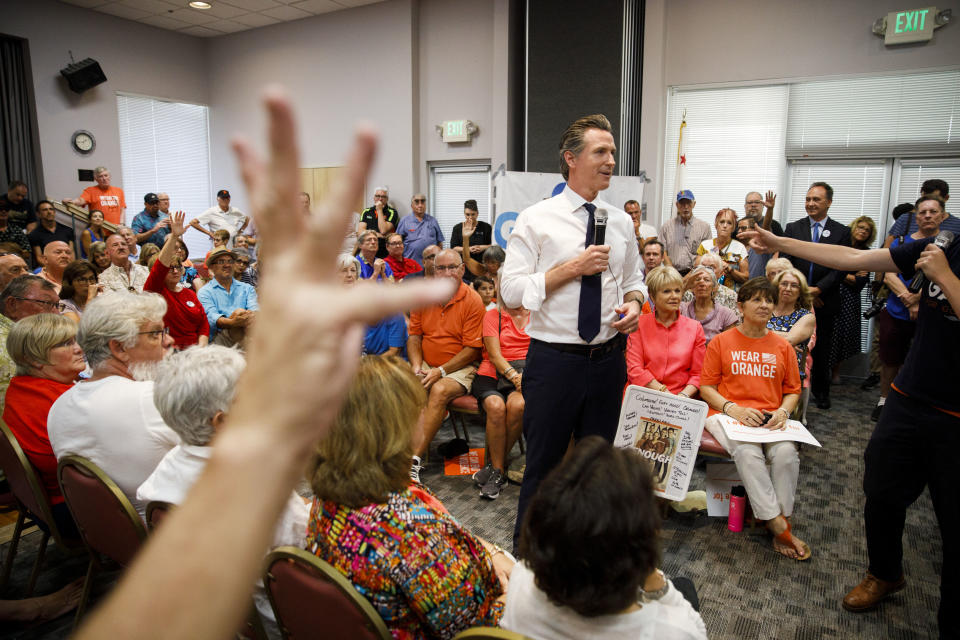
It was an opportunity for Newsom to expand on the issue that had most distinguished him from Villaraigosa. Early on, Newsom decided to be the “single-payer candidate,” and early on Villaraigosa decided to run as a reality check. “Pie in the sky doesn’t put food on the table,” Villaraigosa would say, citing objective estimates that put the annual cost of a statewide single-payer system at $400 billion, or twice as much as Gov. Brown’s entire 2017-18 budget. “It’s snake oil.”
At first, Newsom seemed to rise to the occasion. “It is my commitment to you to advance the conversation on universal health care anew,” he said. “I have studied the Beveridge model. I have studied the national health insurance model. I have studied the models of Germany and other countries, which have distinctive health insurance policies, all in that vernacular of single payer. All with different components, different attributes, different liabilities. And I am convinced California can achieve this goal of single-payer health insurance.”
The crowd roared. No one seemed to notice how carefully Newsom had chosen his words: committing to “advance the conversation on universal health care anew” isn’t the same as committing to pass single payer, and saying that California “can achieve this goal” isn’t the same as promising to implement it. Implicit in his hedged rhetoric were the caveats Newsom had already voiced elsewhere, in less rousing settings, about how single payer would not “occur by the signature of the next governor,” but rather take “years,” with “litigation,” “setbacks,” “constitutional questions” and “propositions on the ballot — maybe multiple” — not to mention an unlikely waiver from the Trump administration. Yet Palm Springs chose to hear what it wanted to hear, and the candidate moved on.
Ever conscious of the zeitgeist and how his own image can better reflect it, Newsom knows that boldness, or courage, or whatever you want to call it, is a good look for a Democrat at a time of Trumpian bombast. And he has been bold, even courageous, in the past. But how bold can a governor — even a California governor — really be?

Two months before Stakely’s and Palm Springs, Newsom campaigned in East L.A., a lower-income, heavily Latino section of the city, and walked along Cesar Chavez Avenue. He greeted supporters at Moles La Tia and El Gallo Grill; he shopped for his wife at Nataly Fashions. On the street, he encountered a young community college student battling homelessness and depression. She came from a foster home, she said, and lived in her car while attending school. He told her his family had fostered children too. He seemed moved by her story.
A perennial problem in California, homelessness was the issue that propelled Newsom to the mayoralty in 2004; as a candidate, he championed the controversial Care Not Cash program to slash county welfare checks in exchange for services and housing, and it eventually became part of his “Ten Year Plan to Abolish Chronic Homelessness,” which succeeded in reducing the city’s street population by about 40 percent.
But Newsom’s record was mixed. Though he delivered an annual State of Homelessness address and constantly visited homeless people, service providers and shelters, activists criticized him for busing the homeless out of San Francisco, and his tax incentives and pro-development policies would later make matters worse by luring tech companies and their wealthy employees back to the city. Today, San Francisco and the rest of California are experiencing yet another homelessness crisis; statewide, the homeless population jumped nearly 14 percent from 2016 to 2017, bringing the count to 135,000 people, or a quarter of the national total.
As he rallied a few dozen voters in El Gallo Plaza, these numbers seemed to be on Newsom’s mind. He described homelessness as “the ultimate manifestation of our failure as a society,” and vowed to “be audacious and to move, candidly, in a direction we haven’t moved in decades.”

“Economic growth in this state has been a spectator sport for too many people,” Newsom said. “We are living in a state that is the richest and the poorest state in America. That’s happened on our watch. We own that. We have got to step up our game. Eight million people living below the poverty line. Forty-six percent of our children at or near the poverty level. This is the issue. This is the ‘why.’ It’s why I’m here; it’s why I’m running for governor. We can do more, and we can do better. And so I commit to you, at the core of my soul: This is what drives me. This is my passion.”
Two months later, in Palm Springs, the subject came up again. About halfway through the town hall, Sundra Holden, a 64-year-old black woman with close-cropped gray hair, wire-rim glasses and an aluminum walker, grabbed the microphone from the emcee. She had driven two hours from Downey, Calif., to ask her question.
“I have been homeless twice,” Holden said. “I worked for 42 years in this state. Rent in California has gone outrageous. Nobody can work a regular job and rent an affordable apartment. I am sick and tired of looking at people on TV living in tents and stuff. It’s sickening to see. These are regular people that’s trying to make it every day. What can we do to give a rental that somebody can go live in and be comfortable when they work more than 40 hours a week?”
“I’m sorry for what you’ve experienced,” Newsom said. “And I’m sorry to say you’re not alone.”
“Yeah, I know,” Holden said.

Newsom recited a litany of stats about the unsheltered population and shuttered acute psych facilities. He talked about “brain health.” He said that “shelters solve sleep,” while “housing and supportive services solve homelessness.” But he didn’t say that homelessness — California’s crushing economic inequality — was his “why.”
“In the interest of getting to all the questions, I want you to know the sincerity which I bring to this — the nuance,” Newsom said. “We laid out a detailed plan on the issues of behavioral health, on the issue of substance abuse. And we laid out a 15-point strategy on SSI [Supplemental Security Income] advocacy, whole-person care strategies, these blended interventions around homelessness.”
All of that was true; Newsom has plenty of plans to address homelessness and affordability. But with the primary only a few days away, and other voters to woo, he no longer sounded like the guy who’d come to El Gallo Plaza. He sounded, instead, like a politician with too much to do, and too little time.
Which is what he will be, every day, if he’s elected governor. That’s the problem with promising more than anyone else: People will expect more of you. More boldness. More courage. More audacity. Progressives will expect progress. Moderates will expect moderation. These things aren’t always compatible. And if the lesson the Democratic Party learns from Newsom is that sounding bold wins campaigns, it will be a lesson fraught with risk. Actually governing boldly will be hard enough in California, with its surpluses and its single-party rule; delivering on a national level would be even tougher.
After the event in Palm Springs, Sundra Holden seemed content with Newsom’s answer on homelessness — at least for now.
“Yeah, I’m cool,” she said.
“You believe Newsom would make a difference?”
“He said he would,” Holden replied. “And I’ll find a way to get to him if he don’t.”

_____
Read more from Yahoo News:
Lawyer suing Trump over emoluments expects to see hotel records
How journalists got it wrong about Missouri Gov. Eric Greitens
More young people plan to vote this year. But their key issues may surprise you.
Administration sharks circle Atlantic’s only national marine monument
Detroit’s mayor takes on gentrification as his city bounces back from bankruptcy
Photos: Historic summit between Trump and North Korea’s Kim in Singapore


